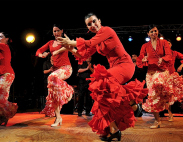
Flamenco
Flamenco is an art form that combines song (cante), dance (baile) and guitar (guitarra). It originated in the 18th century by gypsies in Andalusia – a Southern region in Spain – and it combines musical and dance styles that were influenced by the Moors, Jews, Christians and Eastern European cultures such as the Romans. Both the guitar playing and dancing are extremely passionate, and even the name flamenco reflects this passion as “flama” means flame and “enco” means pertaining to. Therefore, flamenco means pertaining to the flame, or passion. And passion is certainly evident in the dance, singing and guitar playing.
Talented guitar players and singers combine seductive rhythms and lyrics with spontaneous dancing performed by highly-talented dancers. This combination of music and dance is meant to tell a story to the audience. Many times the story relates to love, history, comedy or even politics. However, in most instances the lyrics and guitar melody reflect tragedy and suffering, while the dance is extremely graceful with difficult footwork and an emphasis on maintaining a straight upper-body posture. Nonetheless, the singer is the heart and soul of flamenco. His passionate lyrics tell the tragic story to the audience, while the guitar playing and dance reflect this story and bring it to life.
Although flamenco began in Andalusia, it has spread to many countries around the world, including Cuba, Guatemala, Costa Rica, Panama, El Salvador, Argentina and even the United States. Because of its worldwide popularity, millions of observers crowd into theaters and opera houses to watch flamenco’s great dance and music. But don’t be fooled, some of flamencos best performances can be seen during an improvised jam session on the streets of Andalusia.
These intimate jam sessions, called juergas, take place in the streets, cafes, bars, restaurants and cabarets, and they’re often some of the best displays of flamenco. Juergas bring together talented local performers who play to a small crowd. In these tiny settings, the performers adapt their rhythm and dance to the mood and energy of the audience. These performances are spontaneous, organic and in some cases performers will beat on tables and crates to provide rhythm. Audiences love these performances because they are so passionate and take place in extremely friendly settings. But no matter where you take in a flamenco performance, you’ll be amazed by the intimate relationship you’ll form with the singers, dancers and guitar players.
 Follow
Follow


